Forum Replies Created
-
AuthorPosts
-
 Denis BuczynskiParticipant
Denis BuczynskiParticipantHi Tony,
I looked at my early editon of this atlas and a later one and neither have negative maps included with them. Are the negative maps produced by Sky Publishing in the same way as the positive maps? Perhaps they have been copied from the positive maps by previous owner.When you say you want to research them, what are you wanting to find out?
Denis
ps Skelnate Pleso Observatory and its history is absorbing. The details of the people and and observers there is fascinating. Becvar was just one (maybe the most important) but Mrkos, Padjusakova, Kresak , Vovarova and the other comet discoverers and astronomers there were huge characters also.
6 November 2017 at 6:47 pm in reply to: UK Location of best number of clear nights and seeing #578726 Denis BuczynskiParticipant
Denis BuczynskiParticipantThere doesn’t seem to be a lot wrong with the Tarbatness Peninsula in NE Scotland where I moved to 7 years ago. Plenty of observing opportunities and good views of Aurora too. Long way from anywhere else though, and a maybe a big cold for those southern folk who are used to warmer climes. But for observing I cannot complain.
Denis Buczynski
 Denis BuczynskiParticipant
Denis BuczynskiParticipantHi Tony,
Two of my friends have built run off rooof observatories and they are happy with the outcomes. Here are some details of the rollers and rails they used.
http://www.rollingcenter.co.uk/
The rail for these wheels are the “Angula Z3”. They come in 3 metre length
The wheels were £4.44 each – I got 6
the rails cost £22.64 for a 3metre lengtH
The ‘V’ groove wheels & rails are superb – it really is possible to push it with one finger.Denis Buczynski
 Denis BuczynskiParticipant
Denis BuczynskiParticipantHello all, Here is my image of this extragalactic transient taken lat night (20170911) 23:51 UT. Mag=R 15.8
Denis Buczynski
 Denis BuczynskiParticipant
Denis BuczynskiParticipantI think I would rather look through the 20 inch Dobsonian telescope that you are stood by in your profile picture! I have the feeling that a view through a telescope should be unaldulterated, just photons from space entering the mark one eyeball. If you want to go to electronic imaging then use a ccd or cmos camera. I used to use an image intensifier on one of my photographic guide telescopes to try and make life easier, they worked OK but I would not have liked to spend the night hours looking into one. I assume the new devices are smoother and the noise reduced. What is the difference between these devices and an electronic eyepiece, is it that they are cumulative?
 Denis BuczynskiParticipant
Denis BuczynskiParticipantRichard, Excellent GAML. I watched it on BAA Website on the night of your lecture after Nick uplaoded it. What fantastic service this is.
Part of yor talk mentioned the numerous occasions when serendipitous discoveries of comets have been made by VS observers when comets have appeared in the filed of view of the VS they are observing. This has happened on very numerous occasions throughout history. We had an instance of this earlier this year, as you will see form the following emails from John Toone and Nick James:
From: J TOONE [mailto:enootnhoj@btinternet.com]
Sent: 02 April 2017 05:33
To: Guy Hurst
Subject: Comet Object QueryGuy,
At 03:38GMT this morning (2nd April 2017) whilst observing AG Peg, I noted a comet object at the following position:
RA 21h 49.9m, Dec +12d 52m (2000) [0.4 degrees NP AG Peg]
It was perfectly round, well condensed and estimated to be mag 8.7 (equal to K on the AG Peg sequence).
I observed the object again at 03:50GMT and noted no change in position, the sky clouded over 10 minutes later.
Would appreciate you confirming the object’s designation.
Best Regards
John
Subject: Re: Fw: Comet Object Query
To: J TOONEFrom: Nick James
John,
It’s C/2017 E4 (Lovejoy). See my pic from this morning attached.
Nick Denis BuczynskiParticipant
Denis BuczynskiParticipantThere is a printed copy of the index for the first 50 years of the JBAA. I had a copy which I sent (along with a large set of old JBAA’s) for the scanning project for the DVD’s. My old JBAA’s and the index were part of the library which Reggie Waterfield left me in his will. I got the JBAA’s back (these have now been donated to the BAA Archive with Richard McKim) but my copy of the Index was never returned. Sheridan Willams (who did the scanning) said that ther were only two copies in the BAA Library. It was pity that my copy never made it back to me. If it does turn up let me know.
Denis Buczynski
 Denis BuczynskiParticipant
Denis BuczynskiParticipantThat is a nice montage of images of Robert’s most famous of comets. I have one of those given to me by Rob when he stayed with me after his UK tour in 2015. He returned to OZ after the devastating bush fire that totally destroyed his home near Coonabarabran which wasclose to the UK Schmidt unit and th Upsala Southern Schmidt where he made so many comet discoveries.I was in regular contact with him after his return via email but no contact for over a year now. I asked Malcolm Hartley,one of the astronomers at the UK Schmidt unit who lives in Coonabarabran and who Rod stayed with recently, if he could let Rob know that we want to re-establish contact with him. His last idea was that he was going to restart his visual search for novae in the Southern skies. Perhaps he has gone walk about instead! If any one has contact with him could you please ask him to contact either Guy Hurst or myself. He has a sister who lives in Edinburgh, so if anyone knows her address let me know.
Denis Buczynski
 Denis BuczynskiParticipant
Denis BuczynskiParticipantHi all,
I was able to observe on 100 nights over 10 months in 2016. This excludes the months of June and July when the night sky is too bright at 58dN latitude for imaging. I was able to observe 75 individual comets and report 1800 astrometric postions to the MPC. Comets are my main observing interest. I also operate two automatic meteor cameras which work all night every night to produce monthly reports the BAA NEMOTODE network. I image any displays of Aurora and report these to the BAA Aurora Section. During the bright Summer months Noctilucent clouds are observed and imaged an reported. I also use some observing time to make time series observations of HADS stars which I report to the BAA VSS. In addition I image any bright Novae and Supernovae and any bright NEO’s. In all a good year for NE Highland Scotland for my observing year.Recorded rainfall was 713mm for 2016 here at Tarbatness.
Denis Buczynski
 Denis BuczynskiParticipant
Denis BuczynskiParticipantNice image Peter. This is an interesting comet. When discovered it was very diffuse as it approaches perihelion it is becoing more condensed. There are questions about whether this is a new comet on its first visit to the inner solar system and if this is so that it may not survive perihelion passage. It could be returning comet or a fragment of another older comet, It will be interesting to observe its eventual fate. As always with comets expect the unexpected we can never be sure what will occur.
Denis Buczynski
 Denis BuczynskiParticipant
Denis BuczynskiParticipantThat is bad news that publication is ended. I have all the volumes from 1962 to 2016. There are some great articles amongst them. Would it be possible to produce a PDF version with a fee to download it from a link with a password. That way the production and printing costs would be minimal and committed readers would still get the product they want. Perhaps the BAA could take this on as a service to members and a memorial to Patrick Moore. With the material already written for 2017 it would be worth a try to see how it worked out for one year. How about it BAA?
 Denis BuczynskiParticipant
Denis BuczynskiParticipantImage taken at Tarbatness Observatory Highland Scotland
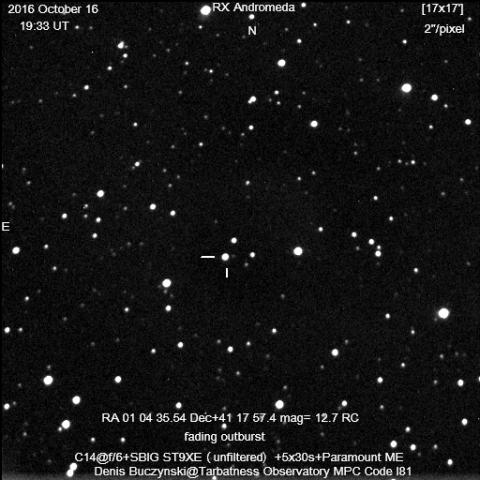
 Denis BuczynskiParticipant
Denis BuczynskiParticipantHello all, Very interesting to read everyone’s selections. I am sure the same books will come up time and time again. Here is my rather long list ( not that I am well read)
Hutchinsons Splendour of the Heavens
The Larousse Encyclopedia of Astronomy
Celestial Objects for Common Telescopes(2 vols)
Amateur Telescope Making (3 vols)
100 years of Astronomy ( Waterfield)
The Amateur Astronomer (Moore)
Constellations (Rukl)
Nortons Star Atlas (1950 and 2000)
The Planet Saturn History of Observations etc( Alexander)
History of the Harvard College Observatory (Jones and Boyd)
Starlight Nights (Peltier)
History of the Telescope (King)
Analysis of Starlight (Hearnshaw)
Planet X and Pluto (Hoyt)
Cometography (Kronk 5 vols)
Burhams Celestial Handbooks ( 3 vols)
The Messier Album (Mallas and Kreimer)
Astronomical Scrapbook (Ashbrook)
Sorry it is so long, there are many more!
Denis Buczynski Denis BuczynskiParticipant
Denis BuczynskiParticipantI enjoyed watching the sky notes and look forward to seeing the rest of the meeting talks on video. I really appreciate this service as part of my BAA membership.Living so far away from London I cannot attend meetings. However I do want to hear the talks and lectures given by the excellent speakers that the BAA ( Hazel Collett) persuades to participate at our meetings. I was worried that this video service would go by the wayside due to the large effort required by the compiler to complete the task. I am very happy to see it continue and would like to personally thank Dominic for posting themfor us to see.
Denis buczynski
 Denis BuczynskiParticipant
Denis BuczynskiParticipantHello all, Attached is an Ha image of the transit just after mid transit.
Apologies the AR numbers should be 25 etc not 24 etc
Denis Buczynski Tarbatness
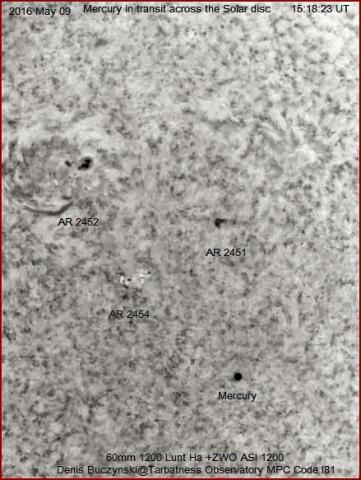
 Denis BuczynskiParticipant
Denis BuczynskiParticipant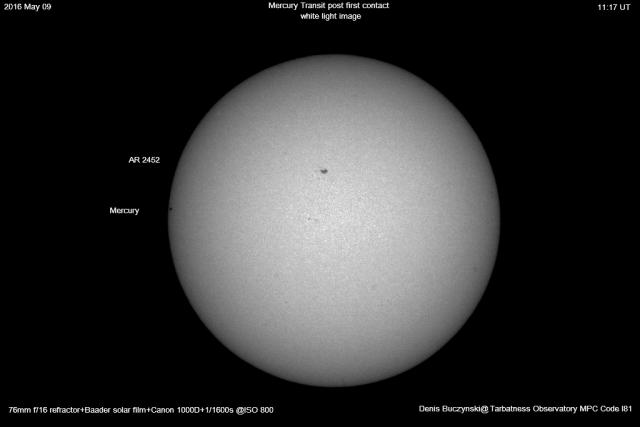 Hello all, Attached is an image I took of the transit just after first contact. Conditions here at Tarbatness are clear with a cold easterly wind , temperature 10d C. Seeing was fair. Mecury looks a very inky black dot in the Ha view, some small prominences also on view.
Hello all, Attached is an image I took of the transit just after first contact. Conditions here at Tarbatness are clear with a cold easterly wind , temperature 10d C. Seeing was fair. Mecury looks a very inky black dot in the Ha view, some small prominences also on view. Denis BuczynskiParticipant
Denis BuczynskiParticipantHello James, Donati’s comet has been described by many of the 19th Century observers who saw it as the most beautiful comet. Both in scale in the sky, in form with the curved dust tail and the thin straight gas tail. It was painted by many artists, whose paintings can be seen by searching for images of this comet on Google.It was an important comet as it was the first comet to be photographed. This feat was achieved intially by an English Portrait Photographer William Usherwood then by G.P.Bond at Harvard Observatory in the USA. My particular favourite painting of this comet is by James Poole and is held at Sheffield Museum

Denis Buczynski
 Denis BuczynskiParticipant
Denis BuczynskiParticipantHi Roger,
I am happy with my Opticstar 80mm F/6.3 APO forwide field imaging with CCD and DSLR. Here an image of C/2014S2 taken with this budget OTA. The DSLR needs a field corrector to cover the bigger chip than the CCD.
Denis Buczynski
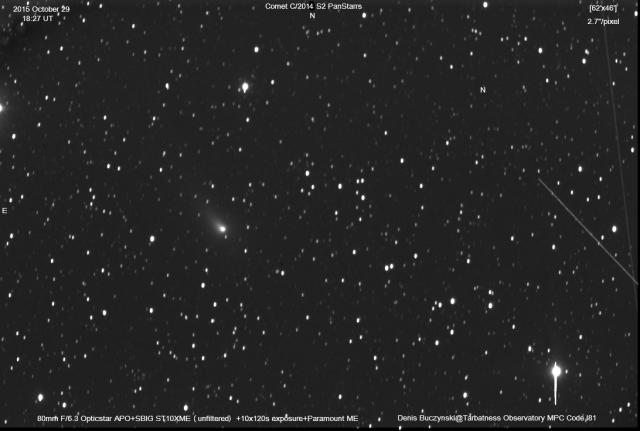
 Denis BuczynskiParticipant
Denis BuczynskiParticipant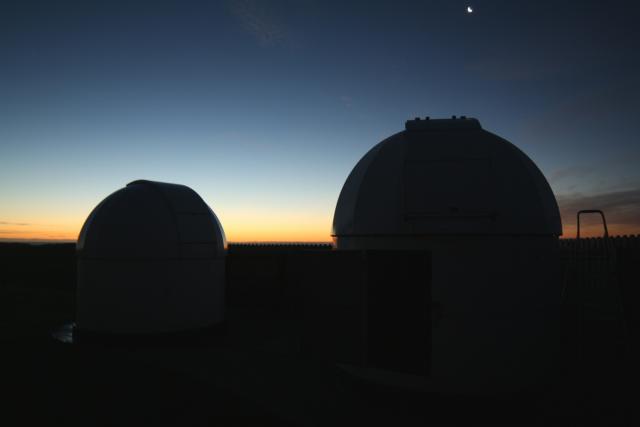
My observing stats at Tarbatness Observatory MPC Code I81 in Highland Scotland for 2014 are as follows:
JAN5 FEB17 MAR12 APR12 MAY4 JUN0 JUL0 AUG13 SEPT7 OCT 9 NOV13 DEC 10 total 94 nights = 1 night in 4 (1 in 3 nights if the summer 3 months are excluded)
These are defined as nights when I undertook CCD images for Comets or VS or TOCP confirmations . The summer months at 58d N lat are unusable due to all night twillight when observing is halted in MAY, June and July. These stats do not include nights when aurora and NLC observations were made. Rainfall here for the year was 855mm, this was slightly higher than the 18 year average of 796mm, so a bit wetter this year and substantially wetter than last year at 673mm.
 Denis BuczynskiParticipant
Denis BuczynskiParticipantKevin Hills has also mad a video of this event, he writes:
I managed to get 160 frames, 45 seconds each with a 0.4m Ritchey-Chretien telescope and SBIG 1001E in Moorook, Australia. At the dropbox link below you will find an animation made in Maxim DL, but beware, the file is large (18mb zipped, 167mb raw) so will take a while to load. Maybe there is a way to reduce the file size, but it’s my first animation…https://dl.dropboxusercontent.com/u/53940961/CK13A010%20and%20NGC362.zip
-
AuthorPosts
